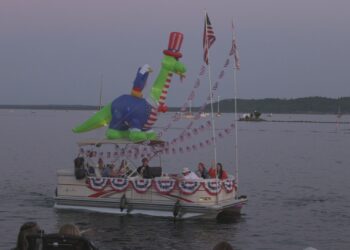MENOMINEE. Mich. – (WZMQ) – Residents of Oscar G Johnson VA Medical Center’s Community Living Center embarked on an eye-opening field trip to Enstrom Helicopter Corporation, uncovering a hidden gem in their own backyard. They were greeted with warmth and enthusiasm, diving into an experience that not only brought smiles, but also enriched their lives.
The Chief Operating Officer of Enstrom, Dennis Martin, revealed a striking statistic: Around 30 percent of Enstrom’s staff are veterans. He emphasized the mutual benefit for both the company and local veterans, providing them with a platform to utilize their invaluable skills while still living close to home.
“They’ve got this skill, this amazing skill. It’s like, what do you do with it? You know, I want to live at home, but I’ve got this amazing skill. Well, we give them a place where they can use that skill, that knowledge that they’ve got but still live, home.’
Enstrom produces around 20-30 aircraft per year, each taking about 9 months to build. Enstrom builds crafts for a variety of foreign militaries, with the Japanese army being the current largest customer. Other foreign customers are Thailand, the Peruvian Air Force, and right now 2 aircraft are being delivered to the Zambian Air Force.
“We’ve got two guys in Zambia right now,” informed Dennis Martin, Enstrom’s Chief Operating Officer.
Enstrom’s production rate of 20-30 aircraft per year, including orders from foreign militaries like Japan, Thailand, and Zambia, left the veterans in awe. Martin’s candid remark about the preference for French and German helicopters by the U.S. Government sparked a lively discussion among visitors.
“Unfortunately, the U.S. Government likes to buy French and German Helicopters, that’s where our tax money goes. Take it up with your senator,” he expressed.
Kenneth Shimun, a resident of the VA CLC, shared poignant memories of his time in Da Nang, Vietnam with WZMQ, reflecting on the challenges and camaraderie of flying helicopters in combat zones, backing up a lieutenant, and successfully removing a downed aircraft from an enemy zone.
“So we got hit a couple of times, but we made it back in, you know. And one helicopter that got knocked down, [we had] a helicopter pick up the other helicopter, and fly out of there. We actually hauled another chopper all the way. Yeah, fly it back to Da Nang. So the enemy wouldn’t get a hold of the helicopter mechanic,” explained Shimun.
Shimun said flying a helicopter, while a challenge without much room for error, is like riding a bicycle once you’re used to it.
´It’s not bad, they’re not that bad, the engines on top and the blades are not that bad. They actually ride pretty smooth. They’re actually a lot smoother than an airplane,” stated Shimun.
“You flew at the seat of your pants. That’s how it was flying helicopters. It was no easy mission. You never know when you’re going to get hit, and you never know when they’re going to hit you, because they’re direct hits from the ground, you know, we fly low over the bushes.´
His anticipation to examine the modern helicopters showcased the enduring bond between veterans and their shared experiences.
Heather LaPalm, the Oscar G. Johnson VA Medical Center’s Activities Director, expressed the collective excitement of the veterans, emphasizing the importance of such outings in reconnecting them with their community, especially in the years following the pandemic. For many, like Jeff Saarele, a former Marine, the trip was a nostalgic journey back to their days of helicopter rides and military service.
´Well, everybody is really excited about going to Enstrom Helicopter for a tour. We try to do things the veterans are interested in, and get them out in the community. A lot of the veterans have worked around helicopters, or they’ve been given transportation as a part of their service, so they have experience with helicopters,” stated LaPalm. “Many people don’t know that Enstrom even exists in our community, and they make, from what I’ve heard, world-class wonderful helicopters. I was an army aviator…and some of the pilots that I”ve talked to that’ve had the privilege of being or flying an Enstrom helicopter. They said they are the Cadillac of helicopters,’ she shared.
Resident Jeff Saarele, a Marine, reflected on flying as a passenger at least 20 times during his service.
‘I just practiced on the ocean. I was a passenger. I was in a jeep, and it was strapped down. And they’d take us to land. And then they’d pick us back up, and bring us back over the ocean to the ship. Then they land us on the ship, and I’d take my jeep off the ship. And it was very exciting,´ he reminisced. Now, Saarele is a talented artist and poet. He painted a picture of an Enstrom helicopter, and revealed he would be presenting the painting to the company’s leadership.
Pete Peterson, another resident, cherished the opportunity to break away from the hospital routine, savoring every moment of the adventure.
‘It gets me out of the hospital. I’ve been here for three years,’ he shared, adding, ‘So every time there’s an opportunity to get out, I go for it. Like to go fishing, to go bowling, or something like that, I’m the first one to go for it.’
Near the end of the tour, the company’s entire staff awaited the CLC residents over the catwalk, clapping and cheering & thanking them for their service. Veteran staff members came down to greet the veterans and share stories.
As the veterans explored the intricacies of helicopter manufacturing, their shared stories and experiences echoed through the halls of Enstrom, underscoring the resilience and spirit of those who have served their country.
For those interested in supporting end-of-life and hospice care for veterans, the Oscar G. Johnson VA Medical Center offers numerous avenues for donations and volunteering, ensuring that the legacy of service and sacrifice continues to be honored.
To find out more, call voluntary service at 906-774-3300, ext. 32780
To learn more about Enstrom Helicopter Corporation, visit:


















